Vermont’s landscape is nature’s own hardy playground, where plants must earn their keep through bitter winters and unpredictable springs. You’ll discover that selecting the right native species isn’t just about beauty—it’s about finding botanical survivors that’ll thrive in zones 3 through 5 without constant coddling. These resilient plants have spent centuries adapting to Vermont’s unique challenges, from clay soils to temperature swings of 100°F or more. The secret lies in understanding which species have already mastered your specific growing conditions.
Contents
- 1 Vermont’s USDA Hardiness Zones
- 2 Beautiful Wildflowers for Vermont Gardens
- 3 Cold-Hardy Native Trees
- 4 Vermont’s Hardy Native Shrubs
- 5 Selecting the Right Native Plants for Your Garden
- 6 Frequently Asked Questions
- 6.1 How Do I Protect Native Plants From Deer Damage in Vermont?
- 6.2 When Is the Best Time to Plant Native Species in Vermont?
- 6.3 Do Vermont Native Plants Require Special Fertilizers or Soil Amendments?
- 6.4 How Much Water Do Established Native Plants Need During Dry Summers?
- 6.5 Can I Grow Native Plants Successfully in Containers or Raised Beds?
Vermont’s USDA Hardiness Zones
Understanding your gardening zone is like having a roadmap for plant success, and Vermont’s hardiness zones have shifted dramatically in recent years. You’ll now find zones ranging from 4a (-30 to -25°F) to 6a (-10 to -5°F) across the state.
These hardiness zone trends reveal significant warming since 1990. The coldest zone 3b has completely vanished, while zone 6a appeared for the first time in Woodstock and West Windsor areas.
Climate impact is evident throughout Vermont’s regions. Central areas fall within zones 4b and 5a, southern sections mainly sit in zone 5b, and northern pockets remain in zone 4a. The USDA determines these zones using 30 years of comprehensive weather data to ensure accuracy and reliability.
Beautiful Wildflowers for Vermont Gardens
Vermont’s native wildflowers offer stunning beauty while supporting local ecosystems. From showy garden stars to pollinator magnets, woodland treasures, and drought-tolerant varieties, there’s something for every landscape. These hardy perennials include species with umbrella-like flowers that bloom from late summer through fall, creating jewels of autumn color in your garden.
Wild Columbine (Aquilegia Canadensis)
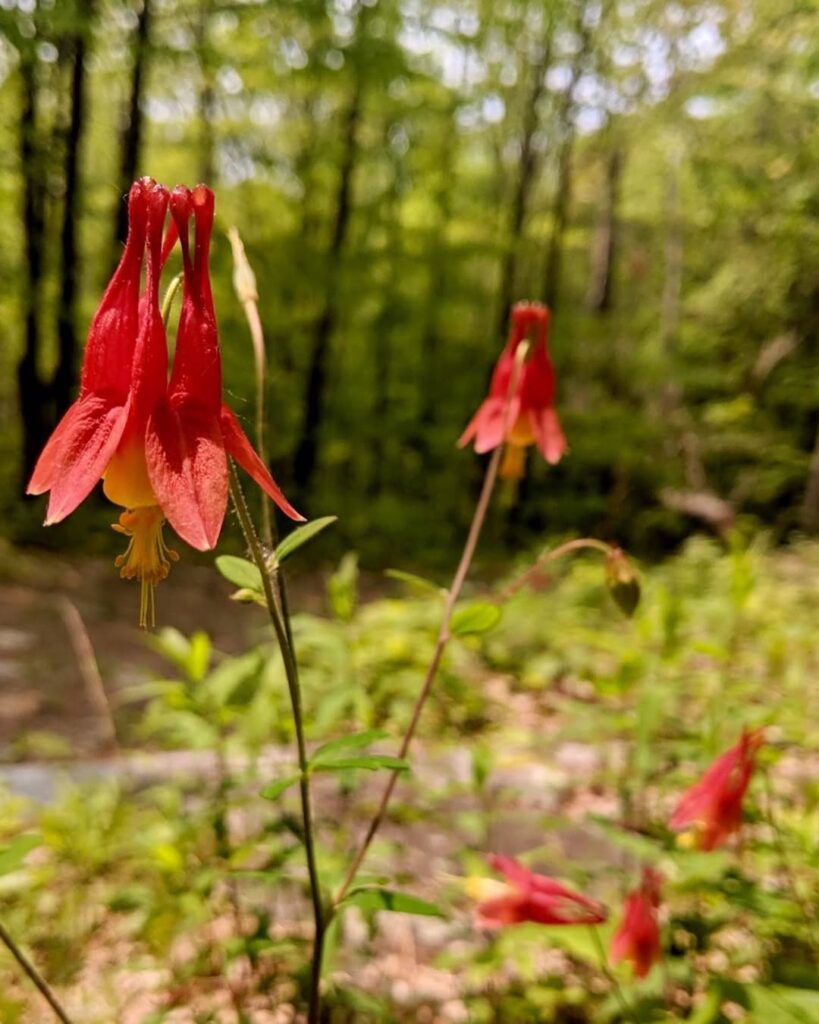
Wild Columbine is a stunning native perennial that brings early spring color to Vermont gardens with its distinctive nodding red and yellow spurred flowers. This adaptable wildflower thrives in diverse settings from woodland edges to rocky slopes, reaching 12-36 inches tall. Blooming from May through June, it serves as a vital early nectar source for hummingbirds and native bees while naturalizing beautifully in shade gardens and wildflower plantings.
Growing from a sturdy underground caudex, Wild Columbine readily self-seeds to form attractive drift colonies. The plant emerges early in spring to take advantage of sunlight before tree canopies fill in, then dies back to its rootstock by late autumn. This low-maintenance perennial is deer resistant and drought tolerant once established, making it an excellent choice for naturalizing Vermont’s native plant gardens. The follicle fruits mature to a tan color approximately two weeks after the flowers emerge, releasing seeds for natural propagation.
- Hardiness: USDA zones 3-8, well-suited to Vermont’s climate
- Light: Partial shade to dappled sunlight; moderately shade intolerant
- Water: Moderate moisture; drought tolerant once established
- Soil: Well-drained, thin soils over bedrock preferred; slightly acidic to neutral pH
- Fertilizer: Low fertility needs; avoid rich soils
- Pest/Disease Resistance: Generally resistant to deer; minimal pest issues
- Growth Rate: Moderate; spreads readily by self-seeding
New England Aster (Symphyotrichum)
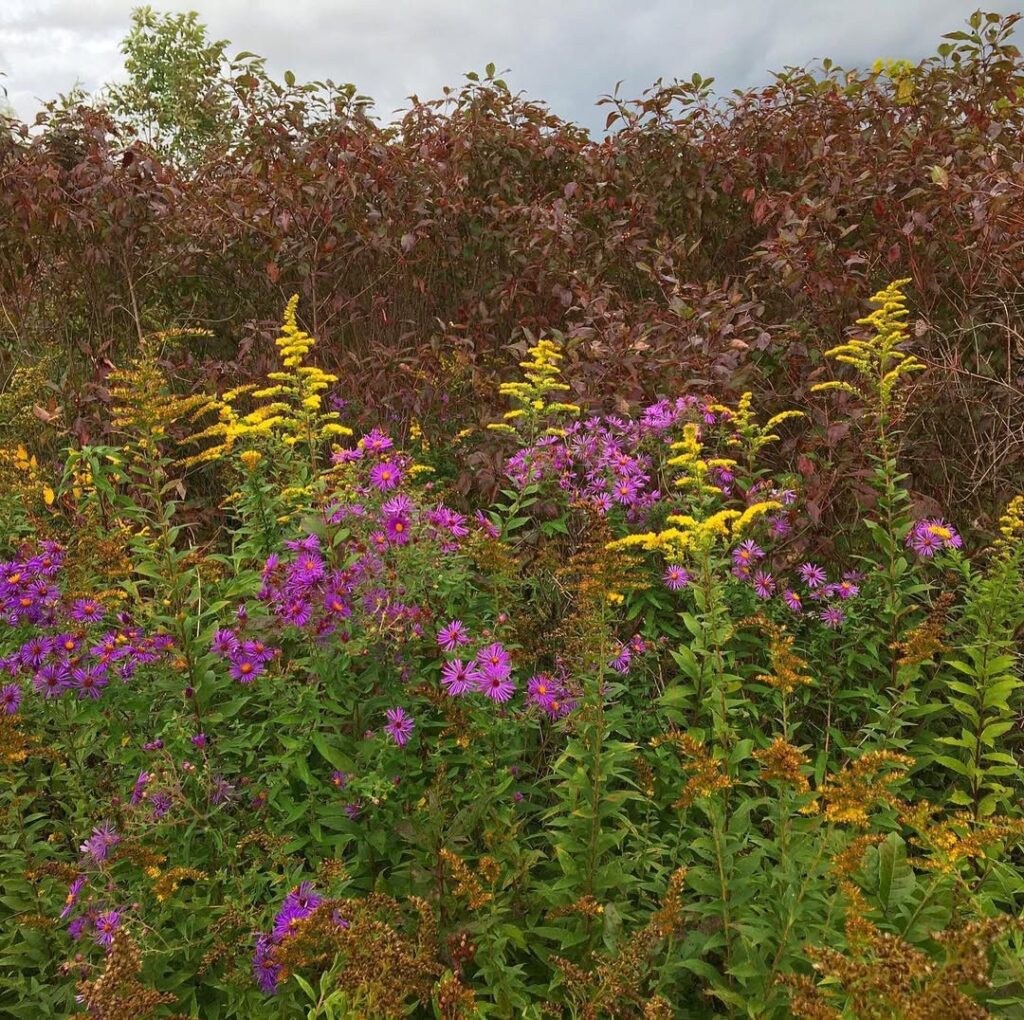
New England Aster (Symphyotrichum novae-angliae) brings spectacular late-season color to Vermont gardens with its brilliant violet-purple daisy-like flowers. Growing 2-6 feet tall, this native wildflower blooms from late summer through fall when most other plants have finished flowering, making it indispensable for extending garden interest.
This hardy perennial thrives throughout New England’s challenging climate and provides essential late-season nectar for butterflies and pollinators. With 45-100 ray flowers per bloom head and aromatic foliage, it works beautifully in naturalized areas, meadow gardens, and borders while supporting local wildlife including Pearly Crescent butterflies. The plant forms natural clumps through its spreading growth habit, creating impressive displays over time.
- Hardiness: Zones 4-8, extremely cold tolerant in Vermont
- Light: Full sun to partial sun
- Water: Medium to moist soil conditions, drought tolerant once established
- Soil: Adaptable to various soil types, prefers well-draining conditions
- Fertilizer: Low maintenance, typically requires no supplemental feeding
- Pest/Disease Resistance: Generally resistant to most pests and diseases
- Growth Rate: Moderate to fast growth, spreads naturally through self-seeding
Wild Bergamot (Monarda Fistulosa)

Wild Bergamot (Monarda fistulosa) is a striking native perennial that brings both beauty and ecological value to Vermont gardens. Growing 2-5 feet tall, this clump-forming wildflower produces distinctive ragged pompom-like flower clusters in shades of lavender, pink, white, or reddish purple from May through September. Its aromatic gray-green foliage emits a pleasant minty fragrance and has been traditionally used for herbal teas.
This Hardy native thrives in Vermont’s climate and attracts numerous pollinators including bees, butterflies, and hummingbirds. Wild Bergamot’s shallow, fibrous root system makes it excellent for erosion control while its tolerance for various soil conditions and drought makes it ideal for low-maintenance wildflower gardens, meadows, and native plant restoration projects. The plant reproduces naturally through rhizome colonization, gradually expanding to form attractive drifts over time.
- Hardiness: Cold hardy perennial, suitable for Vermont climate zones
- Light: Full sun preferred, tolerates partial shade
- Water: Low to moderate water needs, drought tolerant once established
- Soil: Well-drained soils, tolerates poor to average fertility, adaptable to various soil types
- Fertilizer: No fertilizer required, thrives in natural soil conditions
- Pest/Disease Resistance: Moderately resistant to diseases with good air circulation, tolerant of black walnut
- Growth Rate: Moderate growth rate, clump-forming habit
Bloodroot (Sanguinaria Canadensis)

Bloodroot (Sanguinaria canadensis) is one of Vermont’s most cherished native wildflowers, emerging as an early spring herald in woodland gardens. This ephemeral perennial produces distinctive single white flowers with golden centers alongside deeply cleft, rounded leaves that can reach up to two feet tall. The plant gets its name from the characteristic red-orange sap found in its shallow rhizomes, which historically served medicinal and dyeing purposes for Native Americans.
Growing from spreading rhizomes, bloodroot naturally forms attractive colonies that provide excellent spring ground cover before tree canopies fully develop. Its brief but spectacular bloom period makes it invaluable for shade gardens, where it thrives in the rich, organic soils typical of Vermont’s deciduous forests. The plant also adapts well to rocky slopes and various soil moisture conditions found throughout Vermont’s diverse landscapes. While the plant goes dormant by mid-summer, its early season impact and ability to naturalize make it perfect for woodland wildflower gardens.
- Hardiness: USDA Zones 3-9, well-suited to Vermont’s climate
- Light: Partial to full shade, thrives under deciduous tree canopy
- Water: Consistent moisture, particularly during spring growing season
- Soil: Rich, well-drained, humus-rich woodland soil with good organic content
- Fertilizer: Generally unnecessary in naturally rich woodland soils
- Pest/Disease Resistance: Very good, few serious pest or disease issues
- Growth Rate: Slow to moderate, gradually spreading via rhizomes to form colonies
Wild Ginger (Asarum Canadense)
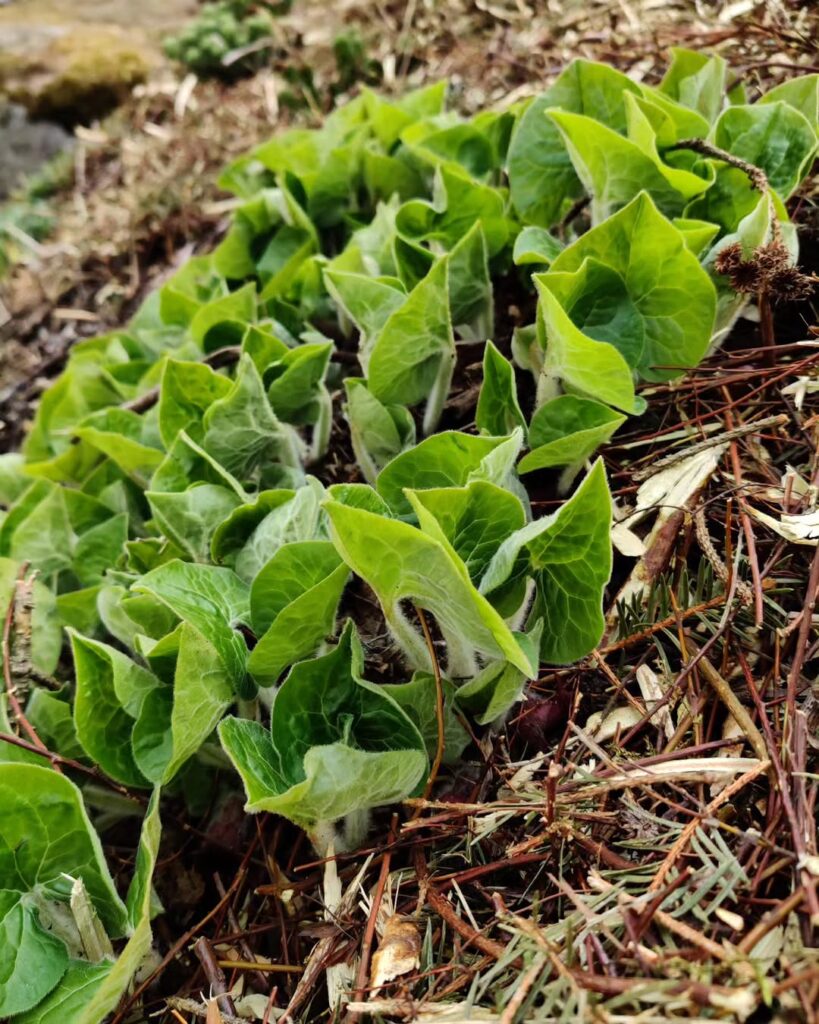
Wild Ginger (Asarum canadense) is a charming native perennial that brings understated elegance to Vermont’s woodland gardens. This low-growing groundcover features distinctive heart-shaped, velvety leaves and curious brownish-purple flowers that hide at the plant’s base, resembling tiny overturned jugs. The plant releases a pleasant ginger-like fragrance when disturbed.
Beyond its ornamental value, Wild Ginger serves important ecological functions as a host plant for Pipevine Swallowtail butterflies while remaining deer-resistant. Its shallow rhizomes spread to form attractive colonies, making it ideal for naturalizing in shaded forest gardens and moist woodland settings throughout Vermont. The plant’s root can be used as a ginger substitute when cooked with sugar, offering both culinary and ornamental benefits to gardeners.
- Hardiness: Zones 3-8, native to Vermont and New England
- Light: Part shade to full shade
- Water: Consistent moisture, prefers moist conditions
- Soil: Rich, well-draining soil with pH 6-7
- Fertilizer: Minimal requirements in rich woodland soil
- Pest/Disease Resistance: Generally pest-free, deer resistant
- Growth Rate: Moderate spreader via shallow rhizomes
Cold-Hardy Native Trees
Vermont’s extreme winters demand trees with exceptional cold tolerance. These hardy natives include deciduous conifers, zone 4 specialists, pollinator supporters, and early-season bloomers perfectly adapted to northern conditions. Oak trees stand out as exceptional wildlife supporters, hosting 462 species of caterpillars that provide crucial food sources for birds throughout the growing season.
Sugar Maple (Acer Saccharum)
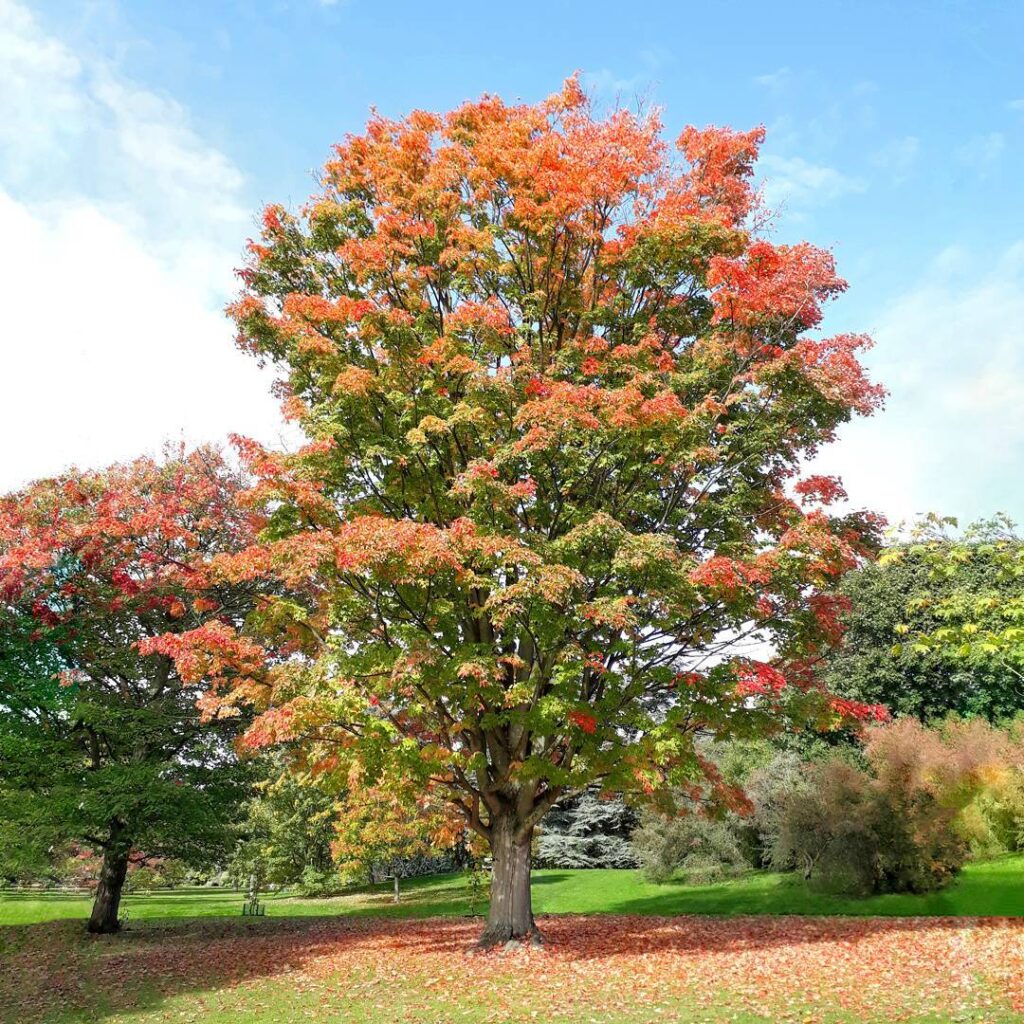
The Sugar Maple (Acer saccharum) is Vermont’s state tree and a cornerstone of the region’s forests and cultural heritage. This majestic hardwood typically reaches 80-115 feet in height with a canopy spread of 50-75 feet, featuring distinctive palmately lobed leaves that create spectacular fall displays in shades of yellow, orange, and red-orange.
Beyond its ornamental value, the Sugar Maple serves as a keystone species supporting forest biodiversity and providing essential habitat for pollinators. It’s most famous as the primary source of maple syrup, making it integral to Vermont’s agricultural traditions and rural communities through widespread sugar bush operations. These remarkable trees can live for 200 to 300 years, making them a lasting investment for future generations.
- Hardiness: Zones 3-8, native to eastern Canada and United States including Vermont
- Light: Full sun to partial shade; forest-grown specimens develop tall trunks, open-growth trees have broader canopies
- Water: Moist but well-drained conditions; supplemental watering may be needed for seedling establishment in high sunlight
- Soil: Well-drained, fertile soils; tolerates range of pH levels; poor competition against herbaceous vegetation in open fields
- Fertilizer: Generally not required in native forest conditions with adequate organic matter
- Pest/Disease Resistance: Generally hardy native species; occasional issues with terminal bud loss causing forking
- Growth Rate: Moderate; approximately 20 feet tall at 10 years
American Basswood (Tilia Americana)

American Basswood is one of Vermont’s most magnificent native trees, reaching towering heights of 75-130 feet in natural forest settings. This deciduous member of the mallow family features distinctive bark with flat-topped ridges and produces small, hard fruits that provide excellent wildlife food. The Legend® cultivar offers a more manageable 55-foot height with superior pyramidal form and branching structure, making it ideal for landscape use.
As an extremely cold-hardy species native to Vermont’s hardwood forests, American Basswood adapts well to various growing conditions while supporting local wildlife through its flowers and fruits. The tree’s ecological value and impressive stature make it a cornerstone species in New England’s native forest ecosystem. The fragrant flowers are particularly valuable to pollinators, attracting bees that produce high-quality honey from the nectar.
- Hardiness: Zone 3a (-35 to -40°F), extremely cold-hardy for Vermont
- Light: Adaptable to various light conditions
- Water: Tolerant of varying moisture levels
- Soil: Requires approximately 28 cubic feet of soil volume, adaptable to different soil types
- Fertilizer: Low maintenance, typically does not require supplemental fertilization
- Pest/Disease Resistance: Generally hardy and tolerant
- Growth Rate: Moderate to fast-growing, reaching significant mature size
Eastern White Pine (Pinus Strobus)
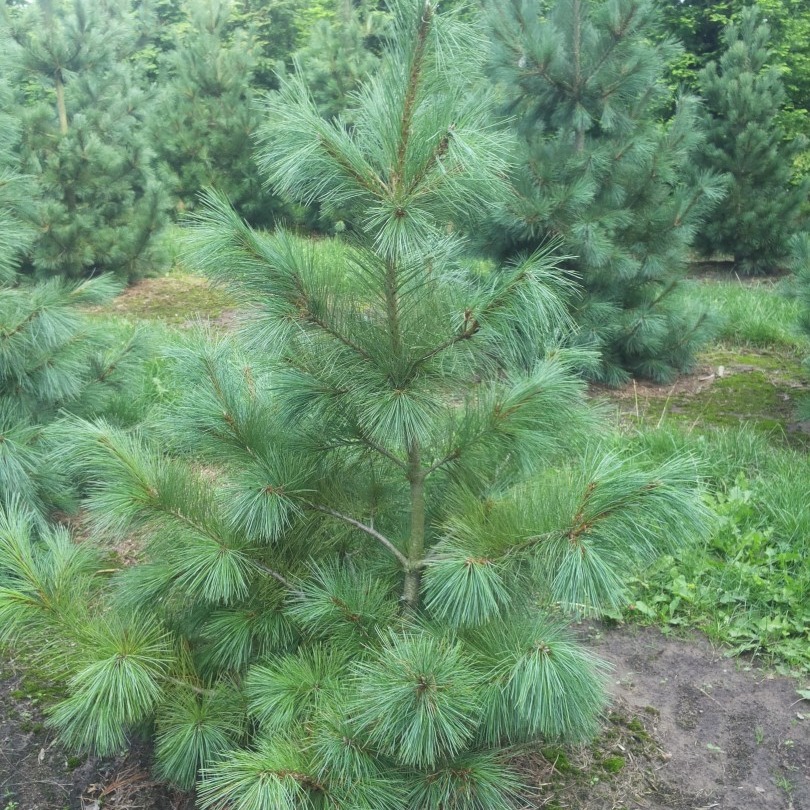
The Eastern White Pine is Vermont’s iconic evergreen conifer, reaching impressive heights of 75-200+ feet with its distinctive soft, bluish-green needles arranged in bundles of five. This graceful tree develops a characteristic plume-like silhouette with whorled branching patterns that indicate its age. Native to northern forests, it serves as an excellent choice for landscaping, reforestation, and timber production.
As one of the faster-growing northern conifers, Eastern White Pine typically reaches 50-80 feet tall in landscape settings. It provides valuable wildlife habitat and food sources while being commercially valued for construction lumber, furniture, and cabinet making. The tree’s adaptability to various growing conditions makes it particularly suitable for Vermont’s native ecosystems and restoration projects. Sprigs of the tree symbolize Vermont identity and appear in various state insignias.
- Hardiness: Cold-hardy native to northern climates, well-suited to Vermont conditions
- Light: Full sun to partial shade, adaptable to various light conditions
- Water: Medium water requirements, tolerates dry to moist conditions
- Soil: Acidic soils with pH less than 6.8, well-drained, fertile preferred; no tolerance for calcium carbonate
- Fertilizer: Low maintenance, performs best in naturally fertile soils
- Pest/Disease Resistance: Generally hardy with good natural resistance
- Growth Rate: Rapid growth among northern conifers, slower initially then accelerating
American Beech (Fagus Grandifolia)
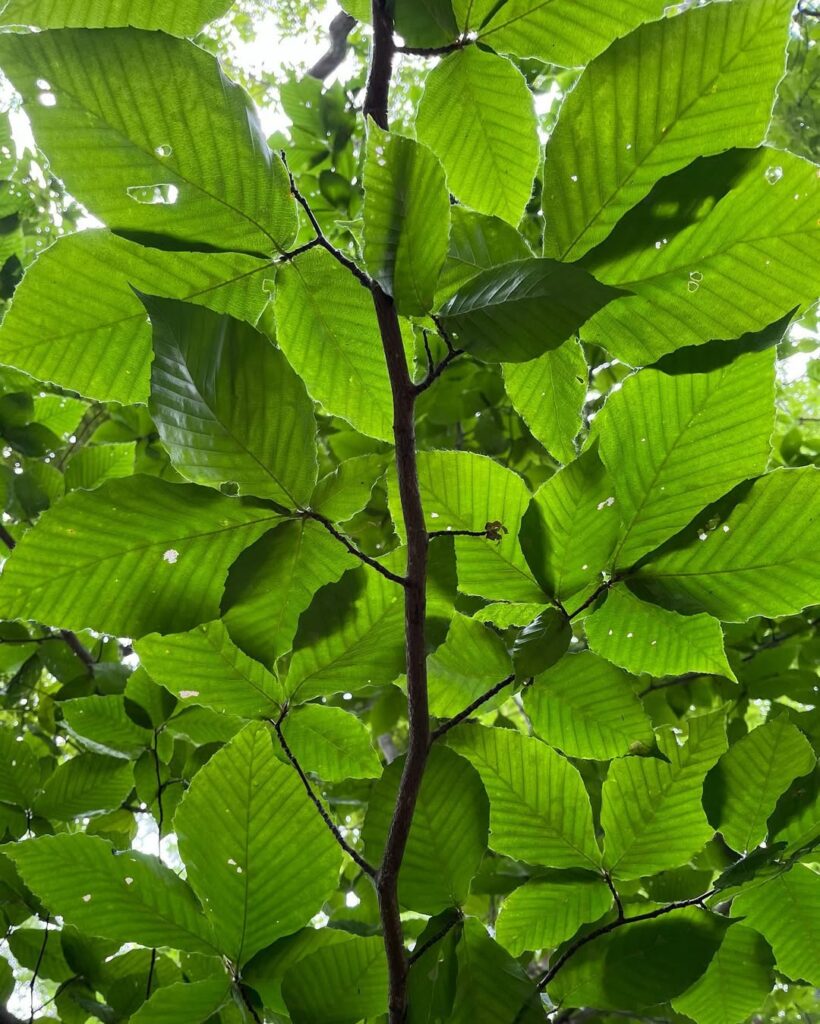
The American Beech (Fagus grandifolia) is a magnificent native deciduous tree that can reach heights of 50-80 feet, distinguished by its smooth, light gray bark that remains unmarked throughout its life. This cold-hardy species produces edible beechnuts that provide valuable food for wildlife including squirrels, bears, and game birds. Notable for retaining its golden-brown leaves through winter long after other trees have dropped their foliage.
American Beech serves as an excellent shade tree with distinctive cigar-shaped buds and toothed leaves featuring parallel veins. The tree reproduces through both seed dispersal and root sprouting, making it well-adapted to Vermont’s climate conditions. The species is particularly vulnerable to root zone disturbance and should be planted where soil compaction can be avoided.
- Hardiness: USDA zones 3-9, extremely cold tolerant
- Light: Full sun to partial shade, tolerates deep shade
- Water: Moderate moisture requirements, drought tolerant once established
- Soil: Well-draining, slightly acidic to neutral soil, adapts to various soil types
- Fertilizer: Low maintenance, benefits from occasional organic matter additions
- Pest/Disease Resistance: Generally resistant, may face beech bark disease issues
- Growth Rate: Slow to moderate growth rate
Paper Birch (Betula Papyrifera)
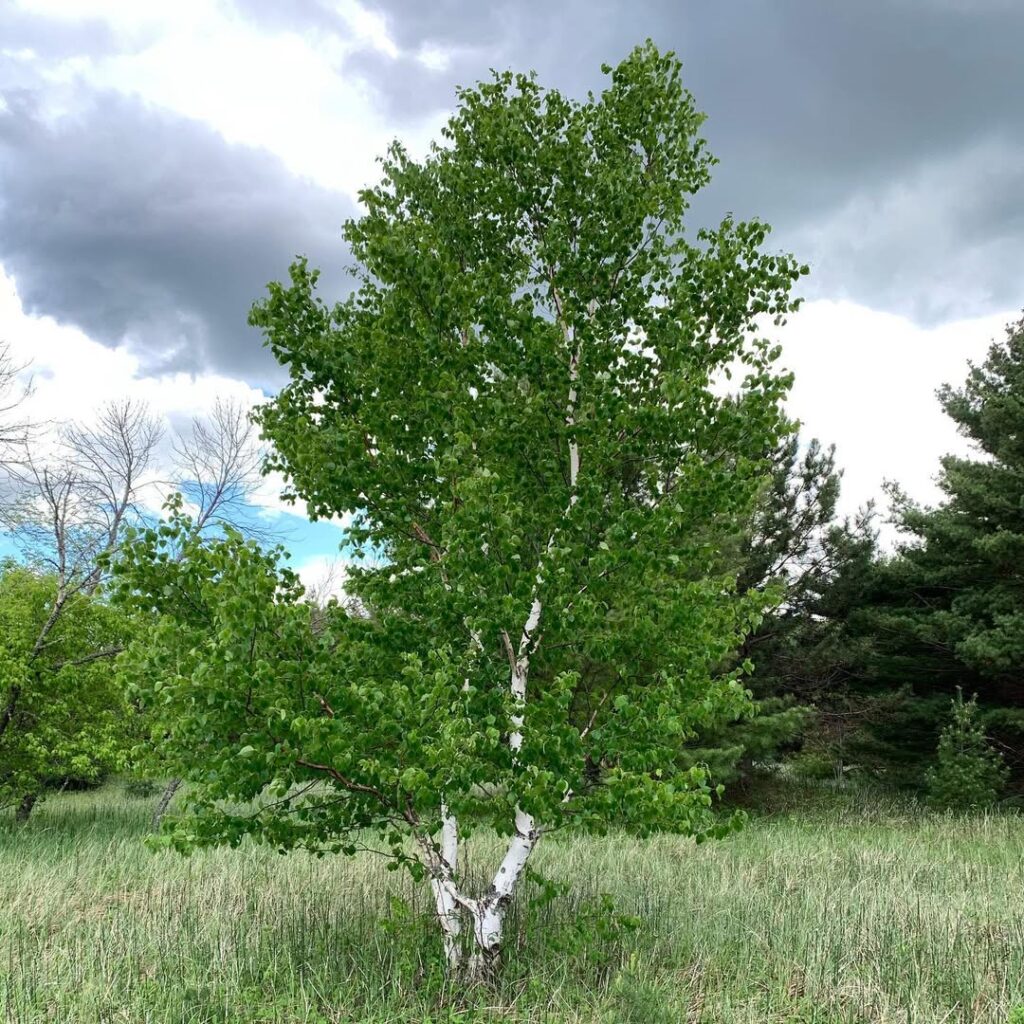
Paper Birch is one of Vermont’s most recognizable native trees, distinguished by its striking white, peeling bark that develops after about 10 years of growth. This medium-sized tree reaches 50-75 feet tall with an open, irregular crown and oval leaves that turn bright yellow in fall. As a pioneer species, it thrives in disturbed areas and plays a vital role in forest regeneration.
Beyond its ecological importance, Paper Birch offers significant cultural and commercial value. Indigenous peoples historically used its waterproof bark for canoes and containers, while today it’s harvested for various wood products. The tree contributes nutrient-rich leaf litter to forest soils and provides wildlife habitat, making it both beautiful and beneficial in Vermont’s landscape. Young saplings demonstrate remarkable flexibility as they can bend under ice without breaking during harsh winter storms.
- Hardiness: Extremely cold-hardy, native to northern climates including Vermont’s harsh winters
- Light: Full sun to partial shade; tolerates various light conditions
- Water: Moderate moisture requirements; prefers cool, moist sites but adaptable to different conditions
- Soil: Thrives on well-drained sandy loams; tolerates wide range of soil types from rocky outcrops to muskegs
- Fertilizer: Low maintenance; naturally contributes nutrients to soil through leaf litter
- Pest/Disease Resistance: Generally hardy with good natural resistance
- Growth Rate: Fast-growing, especially rapid early growth on suitable sites
Vermont’s Hardy Native Shrubs
Vermont’s hardy native shrubs offer exceptional cold tolerance and ecological benefits, featuring species like red-osier dogwood and sweet-fern with diverse landscaping applications and wildlife support. These resilient plants thrive in the nutrient-poor soils characteristic of Vermont’s Northeastern Highlands ecoregion.
American Elderberry (Sambucus Canadensis)
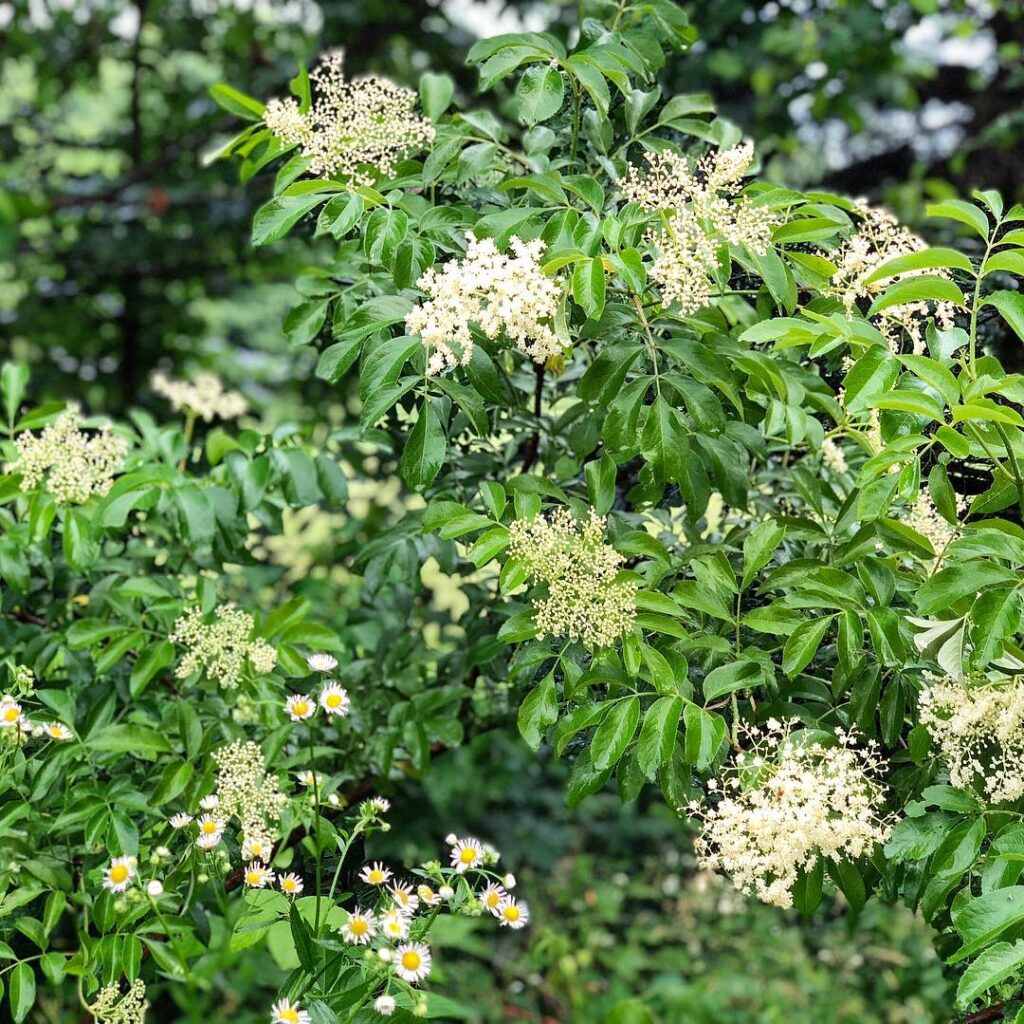
American Elderberry is a deciduous shrub native to eastern North America that reaches 5-12 feet tall with an arching, multi-stemmed growth habit. This resilient plant produces showy clusters of creamy white flowers in late spring followed by dark purple-black berries in fall. Both flowers and berries are edible and commonly used in culinary applications. The shrub provides excellent wildlife value, attracting pollinators and offering food and shelter for birds while serving as an attractive landscape specimen. The bark displays a distinctive yellowish-gray to grayish-brown coloration with characteristic white pith inside the stems.
- Hardiness: USDA Zones 4a-8b
- Light: Full sun (6+ hours) preferred; tolerates partial shade (2-6 hours)
- Water: Prefers moist, well-drained soil; tolerates occasional wetness and some drought
- Soil: Adaptable to clay, loam, sand, and high-organic-matter soils; wide pH tolerance
- Fertilizer: Low maintenance; benefits from organic matter but not heavy feeding required
- Pest/Disease Resistance: Generally resistant to most pests and diseases; very hardy
- Growth Rate: Fast-growing and vigorous once established
Red-Osier Dogwood (Cornus Sericea)

Red-Osier Dogwood (Cornus sericea) is a versatile native shrub that stands out in Vermont’s landscape with its striking red winter stems and adaptable nature. This multi-stemmed perennial typically reaches 3-10 feet tall and forms dense colonies through root spreading and stem layering. The shrub produces clusters of white spring flowers followed by bluish-white berries that persist into winter, providing year-round interest.
Thriving in moist to wet conditions, Red-Osier Dogwood excels in riparian zones, wetlands, and stream banks throughout Vermont. Its extensive root system makes it invaluable for erosion control and soil stabilization. The dense thickets provide excellent wildlife habitat while supporting pollinators and offering food sources for birds and small mammals. The berries are particularly valuable as they resist rot and remain available to wildlife longer than fruits from other native species.
- Hardiness: USDA Zones 2-8, extremely cold tolerant
- Light: Full sun to partial shade (best stem color in full sun)
- Water: High moisture requirements; tolerates wet to seasonally flooded conditions
- Soil: Adaptable to various soil textures; prefers moist, well-draining to poorly-draining soils
- Fertilizer: Low maintenance; typically no fertilization needed in natural settings
- Pest/Disease Resistance: Generally resistant with few serious pest or disease issues
- Growth Rate: Fast-growing with vigorous spreading habit
Winterberry Holly (Ilex Verticillata)
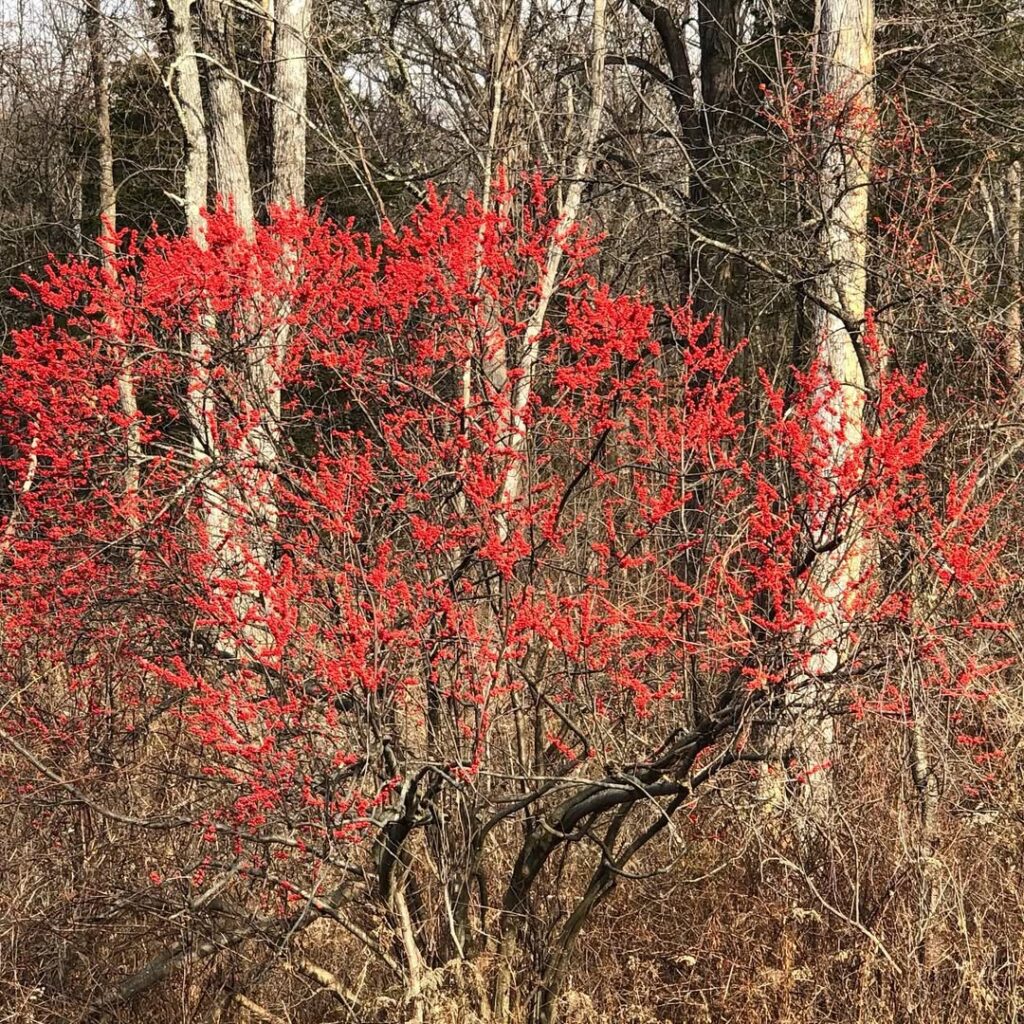
Winterberry Holly is a deciduous shrub native to Vermont and Eastern North America, typically reaching 6-10 feet in height and spread. This dioecious species requires both male and female plants for the abundant red berry production that provides critical winter food for birds from autumn through February. The bright red berries persist after leaves drop, creating striking winter interest in the landscape.
Commonly found along shores of rivers, lakes, and wetlands, Winterberry Holly thrives in moist conditions and is well-suited for rain gardens and areas with periodic flooding. Beyond winter bird feeding, the shrubs provide valuable summer nesting cover for various bird species during the breeding season. Its tolerance for various soil types and challenging sites, combined with excellent wildlife value and low maintenance requirements, makes it an ideal choice for both novice and experienced gardeners seeking native plant solutions.
- Hardiness: USDA Zone 3
- Light: Full sun to partial shade
- Water: Moist to wet soils; tolerates various moisture levels but prefers consistent moisture
- Soil: Clay, sandy, or loamy soils; prefers acidic pH 3.5-6.0
- Fertilizer: Low maintenance; no specific fertilizer requirements mentioned
- Pest/Disease Resistance: Resilient to deer, fire, and salt; low susceptibility to disease
- Growth Rate: Slow-growing
Spicebush (Lindera Benzoin)
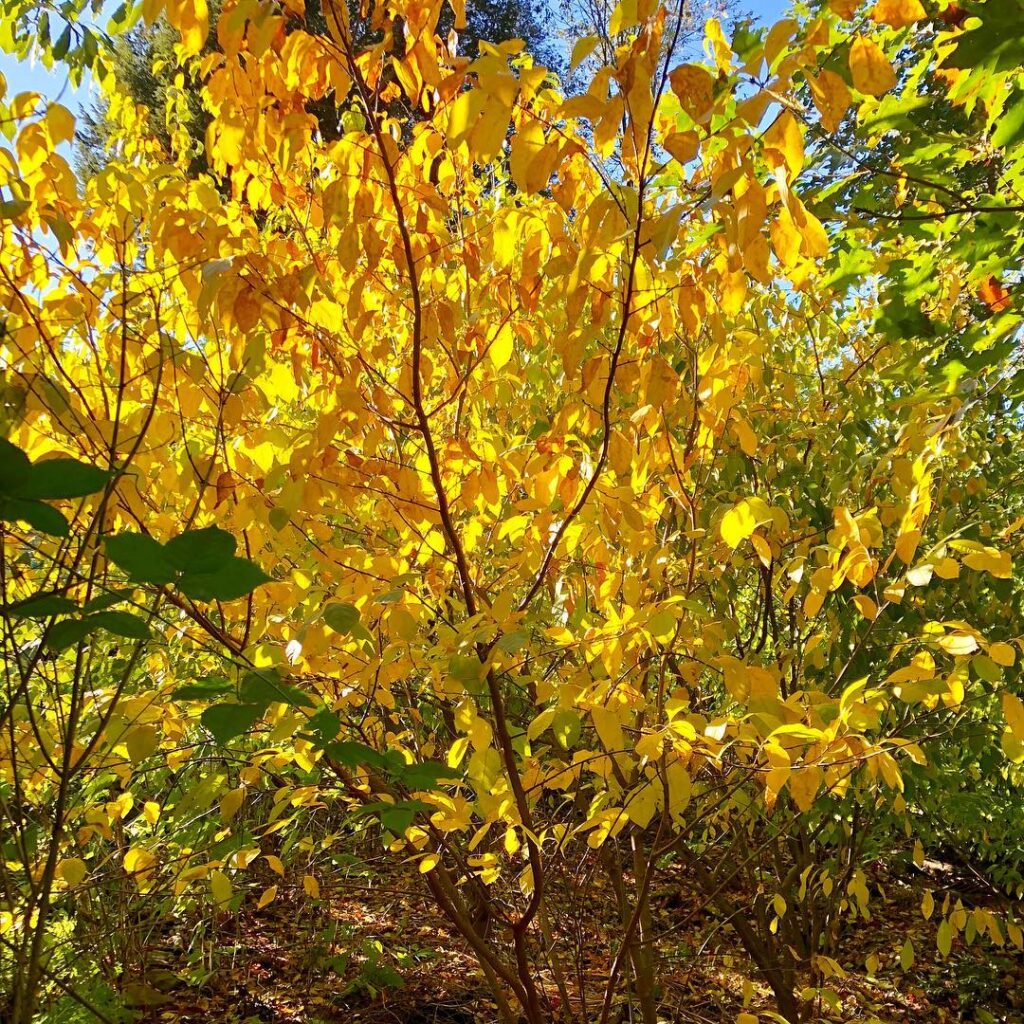
Spicebush (Lindera benzoin) is a deciduous native shrub prized for its aromatic foliage, early spring flowers, and vibrant fall color. This Vermont native typically grows 6-12 feet tall and wide, producing small green-yellow blooms before leaves emerge, followed by glossy red berries that attract wildlife. The crushed leaves and stems release a pleasant spicy fragrance.
As an important host plant for the Spicebush Swallowtail butterfly, this shrub provides exceptional ecological value while requiring minimal maintenance. Its adaptability to various moisture levels and natural deer resistance make it ideal for naturalized landscapes, rain gardens, and woodland settings where it supports pollinators and birds throughout the growing season. This species thrives particularly well in bottomlands and other naturally moist environments.
- Hardiness: USDA zones 4-9
- Light: Partial shade to full sun (with adequate moisture)
- Water: Moist to medium; tolerates wet conditions
- Soil: Wide range of soil types; thrives in moist, well-draining soils
- Fertilizer: Low maintenance; typically requires no supplemental fertilizing
- Pest/Disease Resistance: Excellent; minimal pest and disease concerns, deer resistant
- Growth Rate: Moderate; reaches maturity and flowering in 3-6 years
Serviceberry (Amelanchier Canadensis)
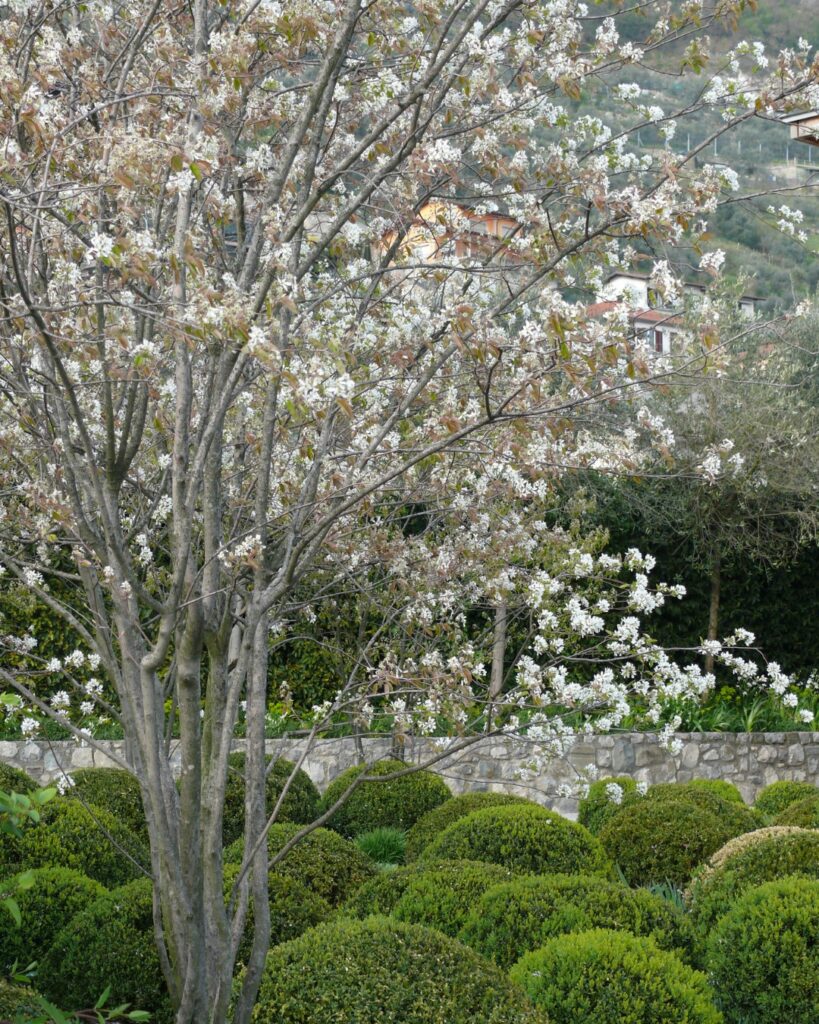
Serviceberry (Amelanchier canadensis) is a versatile native shrub perfectly suited to Vermont’s climate. This multi-stemmed plant grows 8-20 feet tall, producing early spring clusters of white flowers that provide essential nectar for pollinators before most other plants bloom. The edible purple berries ripen by July, supporting both wildlife and human foragers.
This adaptable species thrives in various moisture conditions from moderately dry to wet soils, making it excellent for naturalistic plantings, woodland edges, and streamside locations. Its graceful arching habit and seasonal interest—from spring blooms to colorful autumn foliage—combined with its ecological value as a host plant for butterflies and moths, makes serviceberry an outstanding choice for Vermont landscapes. The species is particularly well-suited to anthropogenic habitats, flourishing in disturbed areas such as roadsides and forest edges.
- Hardiness: Zones 4-9, well-suited to Vermont’s climate
- Light: Full sun to full shade, highly adaptable to various light conditions
- Water: Moderate to high; tolerates both moderately dry and consistently wet soils
- Soil: Moist, well-drained, acidic soils preferred; intolerant of calcareous soils
- Fertilizer: Low maintenance; thrives in natural soil conditions without supplemental feeding
- Pest/Disease Resistance: Generally hardy with good resistance; may experience cosmetic issues but not adversely affected
- Growth Rate: Moderate; reaches mature size of 8-20 feet tall and wide
Selecting the Right Native Plants for Your Garden
How do you choose native plants that’ll actually thrive in Vermont’s unpredictable climate? Start by evaluating your garden’s specific conditions, including salt exposure from winter road treatments and variable weather patterns.
Smart plant placement means matching species to their ideal moisture requirements. Group plants with similar water and sunlight needs together, following a 2:1 slope ratio for proper drainage. Consider heights greater than 6 inches for mature plants.
Focus on hardy natives like nannyberry, buttonbush, and silky dogwood that need minimal maintenance once established. These adapted species will flourish with less watering and fertilizing than non-native alternatives. Native plants also attract butterflies and songbirds, enhancing your garden’s natural beauty and ecological value.
Frequently Asked Questions
How Do I Protect Native Plants From Deer Damage in Vermont?
You’ll need effective deer repellents and multiple fencing options to protect your plants. Install 8-10 foot barriers, use mesh fencing around young specimens, and rotate motion-activated deterrents to prevent browsing damage.
When Is the Best Time to Plant Native Species in Vermont?
Picture frost-kissed mornings giving way to warming soil – you’ll find ideal planting windows in early spring and late fall. These seasonal considerations maximize your native species’ establishment, allowing roots to develop before Vermont’s harsh winter arrives.
Do Vermont Native Plants Require Special Fertilizers or Soil Amendments?
You don’t need special fertilizers for Vermont natives since they’re adapted to local conditions. Test your soil pH first, then add compost if needed. Most native plants have minimal nutrient requirements and thrive naturally.
How Much Water Do Established Native Plants Need During Dry Summers?
You’ll find established native plants need minimal water during dry summers due to their natural drought tolerance. Use deep, infrequent watering techniques only during extended drought periods to support their deep root systems.
Can I Grow Native Plants Successfully in Containers or Raised Beds?
Consider Sarah’s rooftop garden where she successfully grows native wildflowers in containers. You’ll find container gardening and raised bed gardening excellent for native plants, offering better drainage, soil control, and extended growing seasons in limited spaces.
